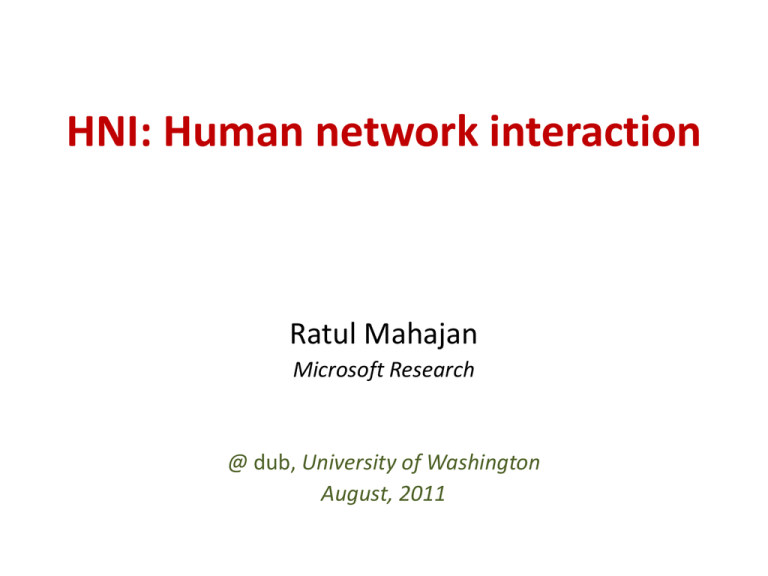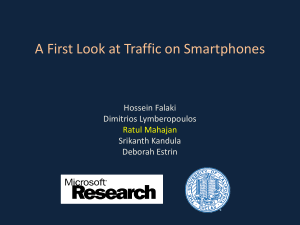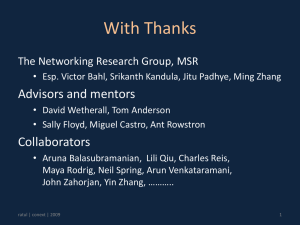HNI: Human network interaction Ratul Mahajan Microsoft Research @
advertisement

HNI: Human network interaction Ratul Mahajan Microsoft Research @ dub, University of Washington August, 2011 I am a network systems researcher Build (or improve) network systems • Build tools to understand complex systems View system building as the art of balancing technical, economic, and business factors • And off late, human factors too ratul | dub | '11 This talk Three case studies • Network diagnosis • Network monitoring • Smart homes ratul | dub | '11 Diagnosis explains faulty behavior Starts with problem symptoms Ends at likely cause(s) File server Configuration Configuration change denies permission ratul | dub | '11 Photo viewer User cannot access a remote folder Key considerations for diagnostic systems Rule based Accuracy Inference based Fault coverage Accuracy: How often the real culprit is identified Coverage: Fraction of failures covered ratul | dub | '11 NetMedic: A detailed diagnostic system Focus on small enterprises Inference based: • Views the network as a dependency graph of finegrained components (e.g., applications, services) • Produces a ranked list of likely culprit components using statistical and learning techniques ratul | dub | '11 [Detailed diagnosis in enterprise networks, SIGCOMM 2009] Rank of the Cause Effectiveness of NetMedic 50 40 30 20 10 0 0 20 40 60 Fraction of Faults 80 100 The real culprit is identified as most likely 80% of the time but not always ratul | dub | '11 Unleashing NetMedic on operators Key hurdle: Understandability Accuracy • How to present the analysis to users? • Impacts mean time to recovery Rule based Inference based State of practice Research activity Fault coverage Two sub-problems at the intersection of systems and HCI • Explaining complex analysis • Intuitiveness of analysis ratul | dub | '11 Explaining diagnostic analysis Presenting the results of statistical analysis • Not much existing work; this uncertainty differs from that of typical scientific data • Underlying assumption: humans can double check analysis if information is presented appropriately An “HCI issue” that needs to be informed by system structure ratul | dub | '11 ratul | dub | '11 [NetClinic: Interactive Visualization to Enhance Automated Fault Diagnosis in Enterprise Networks , VAST2010] ratul | dub | '11 Intuitiveness of analysis The ability to reason about the system’s analysis Understandability • A non-traditional dimension of system effectiveness • Counters the tendency of optimizing the system for incremental accuracy Accuracy A “systems issue” that needs to be informed by HCI ratul | dub | '11 Intuitiveness of analysis (2) Goal: Go from mechanical measures to more human centric measures • Example: MoS measure for VoIP Factors that may be considered • What information is used? • E.g., Local vs. global • What operations are used? • E.g., arithmetic vs. geometric means ratul | dub | '11 Coverage Considerations for diagnostic systems ratul | dub | '11 Accuracy Accuracy Coverage Understandability Network Alarm Monitoring and Triage A large stream of incoming alarms (many per incident) Alarms grouped by incident and appropriately labeled (e.g., severity, owner) Alarm triage Network ratul | dub | '11 Key considerations for triage systems Accuracy CueT Manual Pipeline Full automation Speed ratul | dub | '11 CueT: Cooperating machine and human Use interactive machine learning to automatically learn patterns in operators’ actions ratul | dub | '11 [CueT: Human-Guided Fast and Accurate Network Alarm Triage, CHI 2011] CueT is faster and more accurate 50% speed improvement ratul | dub | '11 10% accuracy improvement Unleashing CueT on operators Key hurdle: predictable control • Predictability in system actions and recommendations • Unlearning bad examples • Direct control for special cases ratul | dub | '11 Speed Accuracy Accuracy Speed Predictable control Considerations for network alarm triage ratul | dub | '11 Smart homes Capability to automate and control multiple, disparate systems within the home [ABI Research] HomeNets | ratul | 2010 21 Why are smart homes not mainstream? The concept is older than two decades • Commercial systems and research prototypes exist Initial hypotheses • Cost • Heterogeneity ratul | dub | '11 Study of automated homes To understand barriers to broad adoption 14 homes with one or more of: Remote lighting control Multi-room audio/video systems Security cameras Motion detectors Outsourced DIY Inventory Semi-Structured Interview Questionnaire Home Tour [Home automation in the wild: Challenges and opportunities, CHI 2011] Four barriers to broad adoption 1. Cost of ownership 2. Inflexibility 3. Poor manageability 4. Difficulty achieving security ratul | dub | '11 Some implications for research Let users incrementally add functionality • While mixing hardware from different vendors Simplify access control and guest access Build confidence-building security mechanisms Theme: Network management for end users • Current techniques are enterprise heavy ratul | dub | '11 HomeOS: A hub for home technology HomeStore Video Rec. Remote Unlock Climate HomeOS Z-Wave, DLNA, WiFi, etc. HomeOS logically centralizes all devices in the home Users interact with HomeOS rather than individual devices Apps (not users) implement cross-device functionality using simple APIs HomeStore helps users find compatible devices and apps [The home needs an operating system (and an app store), HotNets 2010] Status .NET-based software module • • ~20K lines of C# (~3K kernel) 15 diverse apps (~300 lines per app) Positive study results • • Easy to manage by non-technical users Easy to develop apps Small “dogfood” deployment Academic licensing – What would YOU do? Cost Considerations for smart homes ratul | dub | '11 Heterogeneity Heterogeneity Cost Manageability HNI: Human network interaction Humans HNI HCI Computing systems Networks are (often loosely) coupled computing devices • Interactions are more complex and challenging Users are increasingly exposed to the complexity of networks Human factors can be key to acceptance and effectiveness • Must work with realistic models of network systems ratul | dub | '11 Summary Human factors can be key to the success of network systems • Their impact on the design can run deep The complexity of network systems opens up new challenges for HCI research ratul | dub | '11





